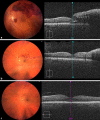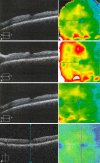[Retinal vein occlusion : Intravitreal pharmacotherapies and treatment strategies for the management of macular edema]
- PMID: 36239802
- PMCID: PMC9562077
- DOI: 10.1007/s00347-022-01735-y
[Retinal vein occlusion : Intravitreal pharmacotherapies and treatment strategies for the management of macular edema]
Abstract
Intravitreal injection treatment for the management of macular edema as an expression of increased capillary permeability and leakage constitute the mainstay of treatment in retinal vein occlusion. In contrast to diabetic retinopathy or neovascular age-related macular degeneration, permanent and complete functional and morphological restoration can be achieved, as retinal vein occlusions are usually associated with risk factors, but do not represent the manifestation form of an underlying systemic or degenerative chronic disorder; however, successful long-term management of retinal vein occlusion -associated macular edema usually requires intensive and also long-term continued treatment with vascular endothelial growth factor (VEGF) inhibitors or with a less favorable side effect profile, dexamethasone. A functional treatment success can be maintained over the long term by both pro re nata (PRN) or treat and extend (T&E) regimens. In contrast, according to the currently available data, the combination of anti-VEGF administration and grid laser treatment has no additional benefit compared to monotherapy. In patients with recalcitrant macular edema, switching to another intravitreal agent may be considered during the course of treatment, although a true therapeutic benefit with respect to the development of visual acuity has not yet been proven. The current review summarizes the relevant aspects in the management of RVO-associated macular edema and provides the foundations for the application of successful treatment strategies.
Intravitreale Injektionstherapien zur Behandlung des Makulaödems als Ausdruck von Schrankenstörungen stellen den zentralen Ansatz in der Therapie venöser retinaler Gefäßverschlüsse dar. Im Gegensatz zur diabetischen Retinopathie oder der neovaskulären altersbedingten Makuladegeneration kann dabei eine dauerhafte, vollständige funktionelle und morphologische Wiederherstellung erreicht werden, da venöse retinale Gefäßverschlüsse in der Regel zwar mit Risikofaktoren assoziiert sind, jedoch nicht als Manifestationsform einer systemischen oder degenerativen Grunderkrankung einen zwangsläufig chronischen Charakter aufweisen. Eine dauerhaft erfolgreiche Therapie des RVO(„retinal vein occlusion“)-assoziierten Makulaödems setzt allerdings eine möglichst intensive und mitunter langfristig fortgesetzte Behandlung mit VEGF(„vascular endothelial growth factor“)-Hemmern oder dem mit einem ungünstigeren Nebenwirkungsspektrum verbundenen Dexamethason voraus. Dabei kann sowohl mit einer PRN(pro re nata)- als auch mit einer T&E(„treat and extend“)-Strategie ein funktioneller Behandlungserfolg langfristig aufrechterhalten werden. Hingegen ergibt die Kombination der Anti-VEGF-Gabe mit einer Laserkoagulation nach aktueller Datenlage keinen zusätzlichen therapeutischen Nutzen im Vergleich zur Monotherapie. In therapierefraktären Fällen kann im Verlauf ein Medikamentenwechsel in Erwägung gezogen werden, wenngleich ein therapeutischer Nutzen hinsichtlich der Visusentwicklung bislang nicht belegt ist. Die vorliegende Übersichtsarbeit fasst die bei der Behandlung des RVO-assoziierten Makulaödems maßgeblichen Aspekte zusammen und vermittelt die Grundlagen zur Anwendung erfolgreicher Therapiestrategien.
Keywords: Anti-VEGF; Branch retinal vein occlusion; Central retinal vein occlusion; Dexamethasone; Intravitreal steroids.
© 2022. The Author(s), under exclusive licence to Springer Medizin Verlag GmbH, ein Teil von Springer Nature.
Similar articles
-
Combination of Intravitreal Corticosteroid with Anti-vegf in Macular Edema Secondary to Retinal Vein Occlusion.Cesk Slov Oftalmol. 2018 Spring;73(5-6):183-188. Cesk Slov Oftalmol. 2018. PMID: 30541298 English.
-
Comparison between Ozurdex and intravitreal anti-vascular endothelial growth factor treatment for retinal vein occlusion-related macular edema: A systematic review and meta-analysis of randomized controlled trials.Indian J Ophthalmol. 2019 Nov;67(11):1800-1809. doi: 10.4103/ijo.IJO_382_19. Indian J Ophthalmol. 2019. PMID: 31638037 Free PMC article.
-
Bevacizumab versus Dexamethasone Implant Followed by Bevacizumab for the Treatment of Macula Edema Associated with Branch Retinal Vein Occlusion.Korean J Ophthalmol. 2018 Feb;32(1):29-37. doi: 10.3341/kjo.2016.0134. Epub 2018 Jan 25. Korean J Ophthalmol. 2018. PMID: 29376223 Free PMC article.
-
Anti-vascular endothelial growth factor for macular oedema secondary to branch retinal vein occlusion.Cochrane Database Syst Rev. 2020 Jul 7;7(7):CD009510. doi: 10.1002/14651858.CD009510.pub3. Cochrane Database Syst Rev. 2020. PMID: 32633861 Free PMC article.
-
The influence of anti-VEGF therapy on present day management of macular edema due to BRVO and CRVO: a longitudinal analysis on visual function, injection time interval and complications.Int Ophthalmol. 2014 Dec;34(6):1193-201. doi: 10.1007/s10792-014-0002-1. Epub 2014 Sep 23. Int Ophthalmol. 2014. PMID: 25245600
Cited by
-
Effect of a novel tyrosine kinase inhibitor nintedanib on bFGF and VEGF concentrations in a rabbit retinal vein occlusion model.Int J Ophthalmol. 2023 Sep 18;16(9):1450-1455. doi: 10.18240/ijo.2023.09.11. eCollection 2023. Int J Ophthalmol. 2023. PMID: 37724275 Free PMC article.
-
Correlation analysis of serum miRNA expression levels with the degree of macular edema in patients with retinal vein occlusion and its clinical implications.Front Neurol. 2025 Jul 22;16:1603790. doi: 10.3389/fneur.2025.1603790. eCollection 2025. Front Neurol. 2025. PMID: 40765619 Free PMC article.
-
Multimodal deep transfer learning to predict retinal vein occlusion macular edema recurrence after anti-VEGF therapy.Heliyon. 2024 Apr 10;10(8):e29334. doi: 10.1016/j.heliyon.2024.e29334. eCollection 2024 Apr 30. Heliyon. 2024. PMID: 38655307 Free PMC article.
References
Publication types
MeSH terms
Substances
LinkOut - more resources
Full Text Sources



